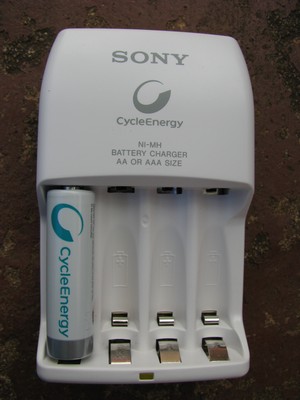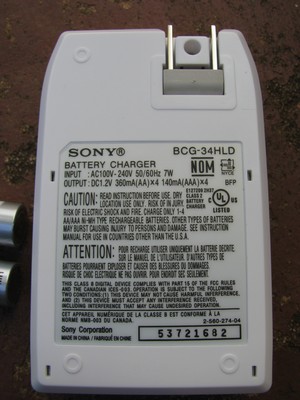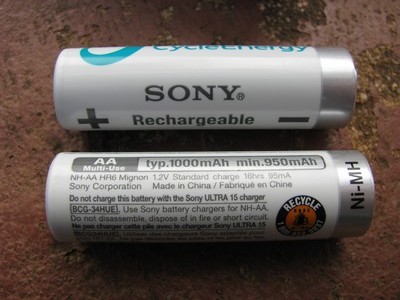Sony BCG-34HLD AA/AAA NiMH Charger
Reviewer's Overall Rating: ★★★★★
Summary:
| Battery size: | AA/AAA NiMH |
| Power: | 110-220 V AC |
| Plug: | US (2 flat prongs) |
| Price Paid: | $5.49 shipped |
| From: | Amazon |
| Date Ordered: | 18 Feb 2011 |
Pros:
- 4 Independent charging bays
- Reasonable charge rate
- Smart termination
- No trickle charge
- Rejects high impedence cells
- Cheap
- Compact
- 110-220V
Cons:
- Only 1 indicator light
- Included AA batteries are only 1000mAh
- Not quick
Features / Value: ★★★★★
It seems like newbie flashlight owners are always looking to pick up a cheap charger for the AA or AAA NiMH batteries and there aren't many good ones to be found. Most chargers only charge in pairs, so when one battery goes bad, that could end up messing up the charging of the other battery it is with. Plus you might never know it. Secondly, many people want their batteries charged as quickly as possible, so they opt for 30-minute or even 15-minute chargers. These chargers stress the batteries and usually do not give them a complete charge. Lastly, there are still chargers out there (I'm talking to you, Energizer) that will actually charge batteries based on a timer no matter whether the battery is full or empty, low capacity or high.
To solve this problem, I wound up buying a Powerex Maha C-9000, which can also analyze batteries and charge at different rates depending on the capacity of the battery and how long you are willing to wait. But that's a $50 charger. Duracell made a charger that met the three requirements of reasonable charge rate, indpendent bays, and smart termination, but it has been discontinued.
Last week the Fry's ad in my local newspaper advertised a Sony charger for only $5.50. The ad didn't have the model number, but based on the chargers Fry's usually carries, I figured out which one it must be and went to Amazon to look for reviews. Some reviews said it was a dumb timer based charger while others said it had smart termination. In fact, the instructions say it will cut off in 7 hours whether the battery is charged or not. That's probably a good thing, just in case the charger misses termination. With a charging current of only 360mA (140mA for AAA), it would take at least 7.5 hours to charge a 2700mAh battery that was fully depleted. But a typical Eneloop would only take 5.5 hours. So 7 hours should work for most people.
Also while at Amazon, I noticed they had the charger for $5.49 and shipping was free! I went ahead and ordered 4 of these so I could give them to people who otherwise might not take good care of their batteries. Also, it will make a good travel charger since it is compact, has folding (US type) plugs, and can take 110-220V AC.
Charger Performance: ★★★★★
On to the tests. The first thing I did was take some partially charged batteries and put them halfway in the charger with my DMM connected to the other half to make a complete connection. A lot of budget chargers will charge at one rate with 1 battery (if they will even charge one battery) then half of that with 2 batteries, and sometimes half of that again when charging 4 batteries. But I soon discovered why this charger doesn't do that: it is a pulse charger, charging the battery at a peak of about 1.4A for about one second out of every four for an average rate of the advertised 360mA (for AAA batteries the peak is 0.56A and the average is 140mA). That seems like a pretty high rate, but if it used a constant charge of 360mA, it probably wouldn't be able to terminate correctly. Even the C9000 can't be trusted to properly terminate at less than 500mA. But by using a high rate, even though it is pulsed, the charger is probably able to terminate correctly. Also Battery University says a low constant charge can lead to memory problem with the battery and recommends a higher charge rate. Though I don't know for sure, I think a pulsed higher charge will help eliminate memory problems while also preventing the battery from getting hot during charging, so the best of both worlds. On the other hand, I do not know if a pulse charge at this rate is a good thing or bad in terms of how many cycles you will get from the battery.
To test smart termination, I took a fully charged battery and put it in the charger. Within 30 minutes the yellow light was off. So it certainly isn't a 7-hour dumb charger. Next I wanted to see how independent the bays were. So I took one fully charged battery and one partially charged battery and monitored the current to the fully charged one. At first it pulsed, just like it usually does, but after about 20-30 minutes, the current dropped to zero. No trickle charge, just zero. Meanwhile the yellow light was still on, so I am assuming the other battery was still charging normally. Perfect!
I also tested the charger on an old Energizer that my C9000 wouldn't charge, indicating HIGH impedence (this is done to filter out alkaline batteries which should not be recharged and have high impedence, but also NiMHs that are old have high impedence and at that point aren't worth keeping). Within a few seconds the yellow light started blinking, indicating the battery was bad. To test the independent bays, I put two good batteries in, getting a solid yellow light, then added the Energizer. The light started blinking again. So while it doesn't tell you exactly which battery is bad, at least it lets you know that one of them is bad.
Batteries: ★★★☆☆
The charger comes with 2 1000mAh Sony Cycle Energy low self-discharge (LSD) batteries. At least this particular package does. Sony gives different model numbers to different charger packages based on the included batteries. The BCG-34HLD charger comes in at least 3 different versions: The BCG-34HLD2RN with 2 1000mAh LSD batteries (which I got), the BCG-34HLD4KN with 4 2000mAh LSD batteries, and the BCG-34HLD4EN with 4 non-LSD 2500 mAh batteries. The chargers with more batteries can be sginificantly more expensive, so I figured it was better to get the one with the cheapest batteries since I have plenty of Eneloops and Duraloops already (if you're buying, at least check out the one with 4 LSD batteries and if it is only a few dollars more, get it and get 4 pretty good batteries).
Even though I plan to give away the chargers, I kept the 1000mAh batteries to run some self-discharge tests on them. These low-capacity batteries are noticeably lighter in weight than other NiMHs I have. Sony says they are good for use in remote controls, alarm clocks, and other low-drain devices where you need the battery to hold a charge for a long time, similar to Eneloop Lite batteries. For flashlights, these batteries aren't so great. And most of my remotes and low-drain devices use AAA batteries instead of AA.
[UPDATE] After 4 weeks I discharged two batteries on my Maha Powerex C9000 and came up with 88% of the original capacity. That's not that great, but even LSD batteries lose a lot of the charge early and then level off. After 3 months two other cells measured 85%. After 6 months the third set had retained 81% of the charge. This is about what you would expect. Maybe not quite as good as Eneloops, but retainining 81% of the charge after 6 months means you can keep these ready in a drawer and they will still provide pretty good life. After 1 year I measured 75% of the original capacity. This is in line with average LSD cells. Still pretty good, but not Eneloops.
| Cell | Original Capacity (mAh) | Storage Time | Retained Capacity | Percent |
|---|---|---|---|---|
| 4 | 1021 | 4 weeks | 899 | 88.1% |
| 6 | 956 | 4 weeks | 842 | 88.1% |
| 2 | 1002 | 3 months | 846 | 84.4% |
| 8 | 994 | 3 months | 853 | 85.8% |
| 3 | 1001 | 6 months | 811 | 81.0% |
| 5 | 1024 | 6 months | 826 | 80.7% |
| 1 | 1022 | 1 year | 772 | 75.5% |
| 7 | 984 | 1 year | 727 | 73.9% |
Summary: ★★★★★
At last there is a decent inexpensive charger for NiMH's. Even at full price this thing is only about $12, which is a bargain considering what it does. If you want more features, Sony has some other chargers that add individual indicator lights and the ability to discharge a battery.


